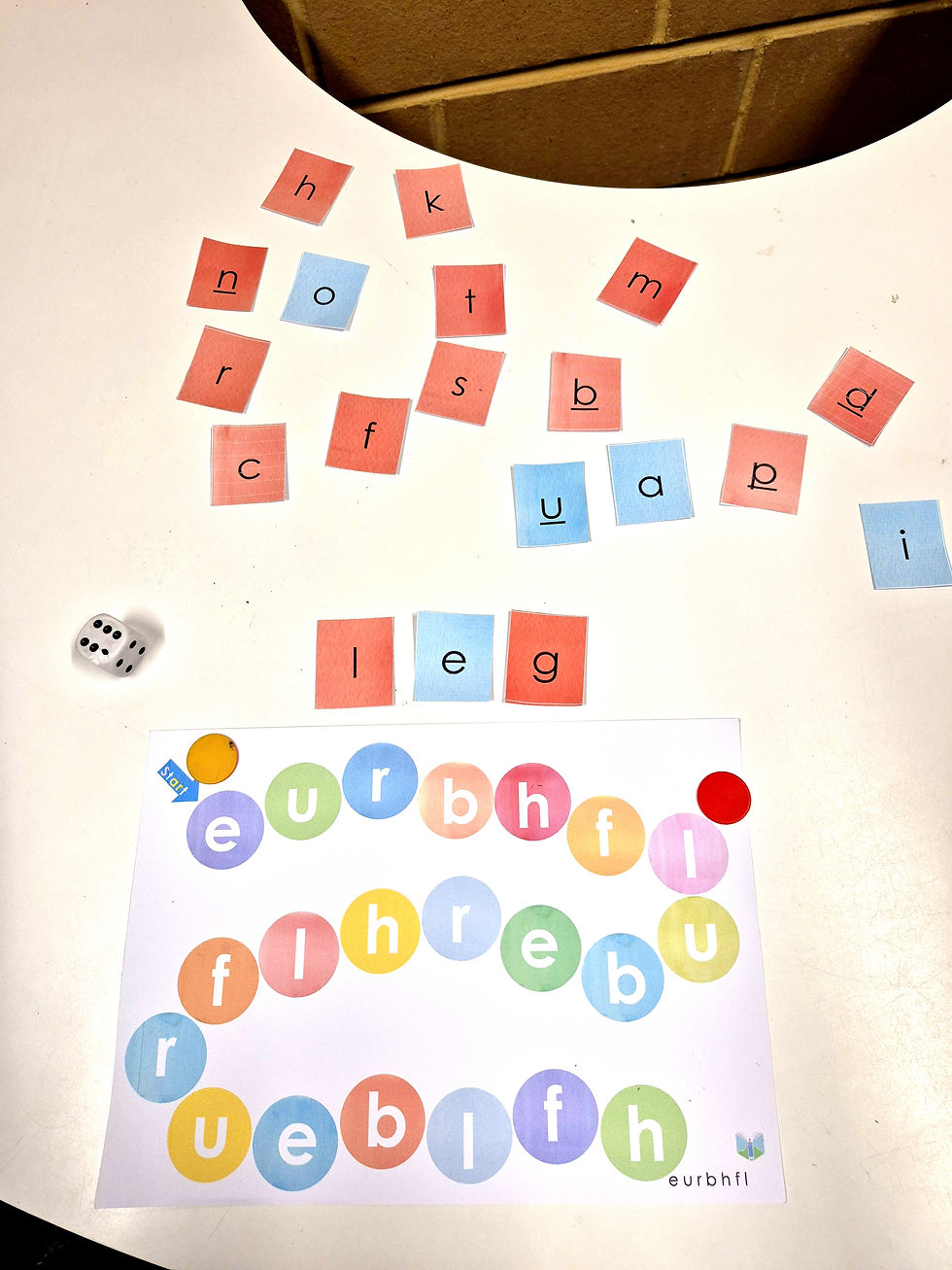REPETITION NEEDS PLAY
- Nov 9, 2022
- 4 min read
Updated: 3 days ago

Phonics lessons are crucial for all. Systematic instruction should include time for repetition to help students consolidate knowledge and skills. However, rereading or repeating the same activity can be disengaging for some students.
Repetition is needed to consolidate new learning and skills, but for some, it can be a challenge if we don't switch the activities to be the same but different. Repetition with variety helps engagement. Learning to read is a hill to climb, and it is exhausting for little ones. We use many of the same, but different, activities in the clinic to build skills and knowledge. In the beginning, it can take many repetitions for initial sounds to stick, and then there is the skill of blending to read. It can all feel too much for some little people. We love to use word building cards and a movable alphabet to encourage blending to read in the clinic.

I have students who shrink at the thought of reading a text more than once until we make the second reading playful. Games can help this process. I always add a game or two to each homework packet.

We use a variety of word lists, cards, track games and sentence strips to get lots of repetition.
Games that build on prior knowledge help develop automaticity and fluency. They are a brilliant tool for repeated practice — the same but different! The same but different again! My First ABC books have lots of games to engage beginning readers.

Why play phonics games?
Games are best played after explicit teaching to support learning and build skills and knowledge through repetition.
5 Reasons to add games to your instruction
Targeted practice
Review and consolidate previous knowledge and skills.
Quick, snappy activities help students stay focused and engaged for longer.
They are a great addition to homework bags. Students love games, and they are far more engaging than a worksheet. It is best to show children how to play a game before sending it home, as this eases the burden on the parent or carer.
Games help to build oral language skills. As you play together, you are modelling how to read and put words into sentences.
Some children struggle when blending to read. Many children get stuck and purposeful play can be an engaging way forward. The jump to read first CVCC and CCVC words can take time and is laborious. A game lightens the load. We love to use our consonant clusters disCARD game for lots of decoding practice.

Games are best used to consolidate knowledge and skills after explicit instruction.
Playful practice is essential to build knowledge and skill. Games can be competitive, but they don’t have to be with the right language and environment —it’s how you set the scene.
Learning first letter sounds can be difficult for some, so games are a must to keep students engaged. Using a game as a prompt for word building can lighten the load.


All students must use and apply their knowledge and skills to improve their vocabulary and build fluency.
Many students in my clinic truly benefit from a playful practice. They are the students who get stuck, get tired quickly, and have low confidence in their abilities. Playful activities are peppered throughout sessions to motivate and change the scene. I use games as a learning and motivational tool. Sometimes, they are a carrot and a stick.
Let’s just read three more pages.
Let’s just write four more words.
Let’s just write two more sentences — then we can play a game.
Games can help to create a meaningful context for learning. They are a fantastic literacy learning tool for struggling readers, helping them gain confidence in a safe, playful space.

All students need time and repetition to use and apply their knowledge and skills to improve and build fluency.

Games are always a source of playful learning. We use many games in the clinic, and I always provide games for repetition at home. BUT they need explicit instruction to be playful. The games in my First ABC books are always a winner with beginning readers.
Bump is one of our favourite games.

Games are a great way to sneak in lots of repeated practice. Many students need lots of time and exposure to gain fluency.
Adapted from the much-loved maths game to give lots of repetition for blending to read.
This game is perfect for students who have already been taught the sounds and alternative spellings and need lots of repetition blending to read. This game is all about playful practice.

How to play
Games are best played as a guided activity.
Use a spinner and 14 counters — a different colour for each player.
Players take turns to spin the spinner, move to the spot, say the word and add to a sentence. The player covers the word with a counter.
If a player gets a number that the other player already covers, they 'bump' the counter off the spot.
If a player lands on a number they have already covered, they add another counter to the top and freeze it. The other player can no longer occupy that spot.
If a player spins the same number again, they can add a counter to create a tower.
Each time a player lands on the same word, they should say the word and create a new sentence.
The first player to use all their counters wins the game!
Fluent reading is the end goal. Children don’t get there overnight. There must be a lot of repetition to enable all children to read fluently. Games are a great way to engage all students. Students consolidate and reinforce the knowledge and skills needed to read fluently every time they play.
Be playful. Your students need it. If you engage, your students are more likely to follow your lead.






Comments